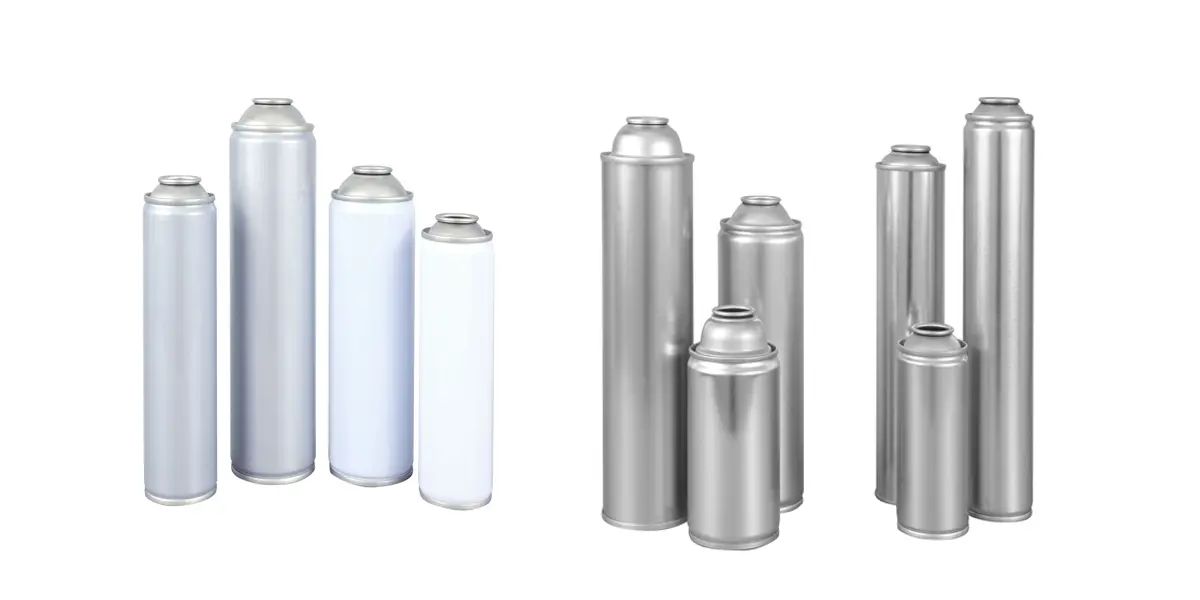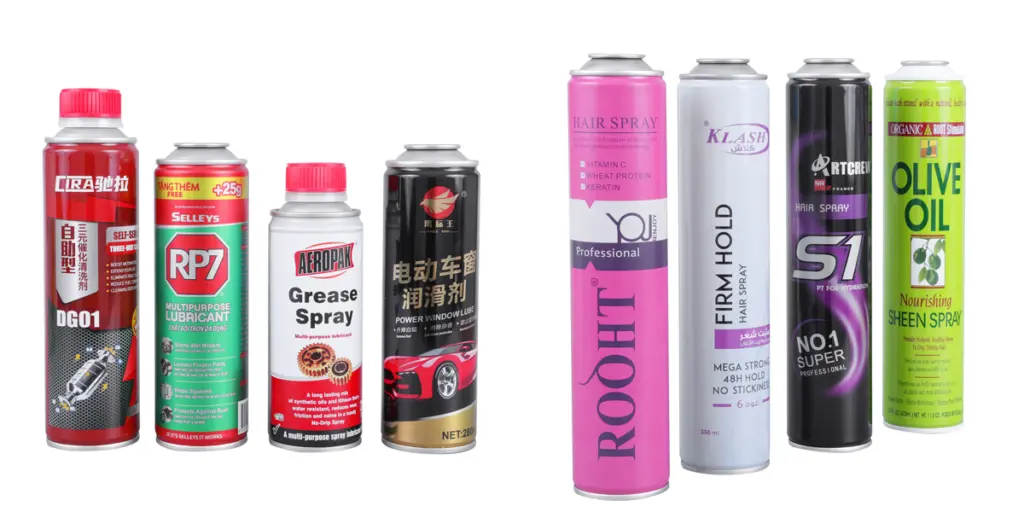
En İyi Aerosol Ambalaj Rehberi
Aerosol ambalajın gelişimi şu aşamalardan geçti: 82 yılların gelişim geçmişi 1942 ile 2024. İlk aerosol kutuları Amerikan askerlerini böcek ısırıklarından korumak için üretildi, Sıtmaya ve sivrisinek ısırıklarından kaynaklanan diğer hastalıklara yol açabilecek. O zamandan beri, Aerosollerin ambalajlanması da hızla kişisel bakıma dönüştü, evde bakım, araba bakımı ve diğer endüstriler. Ürünler dünyanın her yerine yayılıyor. Yaygın aerosol ambalaj ürünleri arasında saç spreyi bulunur, deterjanlar, ve yağlayıcılar. , grafiti sprey boya, vesaire.
Aerosol kabı genellikle yuvarlak bir şişedir veya alüminyumdan yapılmış bir kutudur., kalay veya plastik, aerosol valfına bağlı uzun bir tüp ile. Kullanıcı, ürünü köpük veya sprey şeklinde sprey ile dağıtmak için valfe hafifçe basabilir.
Aerosoller için ambalajlama gereklilikleri
Aerosol ambalajların üretimden kullanıcıların eline kadar olan süreci oldukça titizdir.. Bu süreç şunları içerir::
- Malzeme seçimi: Aerosol ambalajlamanın ilk şartı, yüksek kalitede sızdırmazlık ve korozyon önleyici özelliklere sahip olmasıdır.. Öyleyse, üreticiler genellikle kalay kullanır, malzeme olarak alüminyum veya bozunabilir plastikler. Piyasada genellikle bu üç malzeme kullanılıyor. Aerosol kutuları genellikle yeniden kullanılabilir veya geri dönüştürülebilir.
- Sızdırmazlık ve korozyon önleyici: Aerosol ürününün sızıntı yapmayacağından ve ürünün aerosol ambalaj malzemesiyle reaksiyona girerek ürünün bozulmasına neden olmayacağından emin olun..
- Püskürtme performansı: Kullanıcılar aerosol ürünleri kullandığında, dışarı püskürtülen sıvı, tıkanma veya düzensiz püskürtme olmadan normal şekilde püskürtülebilir.
- Etiketler ve talimatlar: Farklı endüstrilerdeki aerosol ürünlerine göre, Aerosol ambalajındaki talimatlar gereklidir, kullanım talimatları dahil, aerosol maddeler, depolama yöntemleri, vesaire., böylece kullanıcılar kazaları önlemek için aerosolün ilgili bilgilerini açıkça anlayabilsinler.
- Emniyet: Aerosol ambalajının sıkı kalite kontrolünden geçmesi gerekir. aerosol kutu üreticisi fabrikadan ayrılmadan önce, ambalaj malzemelerinin kalitesi dahil, sızdırmazlık, kullanıcı kazalarını önlemek için lastik contalar ve diğer bütünlükler
Aerosol ambalajın faydaları
Aerosol ambalaj, sıvının eşit dağıtımı ve tam kontrol için kolay dik konumlandırmaya olanak tanır ve böylece atık oluşmaz.
Ürününüz için neden aerosol ambalajı düşünürsünüz?? Aslında, bu tür ambalajların kullanılmaya değer birçok faydası vardır, içermek
- Kullanımı uygun: Aerosol spreyin kullanımı çok basittir. Püskürtme yapmanız gereken yönü işaret etmek için bir parmağınızı kullanın ve püskürtmek için nozüle basın. Zahmetli işlemlere gerek yoktur.
- Taşıması kolay: Yaygın aerosol ambalajının taşınması genellikle kolaydır. Kullanıcıların ürünü cebine koyması kolay, çanta veya el çantası ve istediğiniz zaman kullanın
- Güvenlik Özellikleri: Aerosol kapalı ve korozyona dayanıklı bir ortamda bulunur, kırılma anlamı, dökülmeler, sızıntı ve bozulma olasılığı daha azdır. Bu aynı zamanda ürün kalitesini sağlamanın ve kurcalamayı önlemenin etkili bir yoludur..
- Kontrol: Bir düğmeye basılmasıyla, tüketiciler dağıtılmasını istedikleri sprey miktarını kontrol edebilirler. Bu israfı en aza indirir
- Geri dönüştürülebilir: Diğer alüminyum ambalajlar gibi, aerosol kutuları 100% sonsuza kadar geri dönüştürülebilir veya yeniden kullanılabilir.

Aerosol paketlemeyle ilgili hususlar
Farklı aerosol endüstrilerinin ihtiyaçları farklı olduğundan, kullanıcıların ürüne göre kabın boyutunu ve temel rengini belirlemesi gerekir. Kabın boyutunu ve temel rengini belirlemek önemlidir.. Aerosol kutularının boyut aralığı genellikle 35mm-70mm çapında ve 70mm-265mm yüksekliğindedir.. Bir kavanozun tepesindeki en yaygın açıklık bir inçtir. Astar renk seçeneklerine gelince, iki tane var, beyaz veya şeffaf.
Boyut ve renk kaplama seçeneklerini belirledikten sonra, Kavanozlarınızı ürün ihtiyaçlarınıza göre nasıl dekore edeceğinizi belirleyebilirsiniz.. Mevcut dekorasyonlar dış ambalaj tasarımlarını içerir (Ürün özelliklerinizi ambalaja dahil etmek için benzersiz tasarım teknikleri kullanan tasarımcılara dayanmaktadır). kullanıcıya sunuldu) ve şekil tasarımı (yuvarlak, oval, düz/konik veya yumuşak/kurşun şeklinde)
Dikkate alınması gereken bir diğer önemli husus ise Tekliftir. 65 ve BPA standartları. Çünkü BPA'nın insan sağlığı üzerinde olası etkileri olduğu düşünülmektedir., bazı ülke ve bölgelerde belirli ürünlerde BPA'yı sınırlamak veya yasaklamak için düzenlemeler ve standartlar mevcuttur. Öyleyse, ürünün ambalajına ve satış yerine göre ürünün BPA standartlarına uygun olup olmadığına dikkat etmeniz gerekiyor. Ürününüz BPA içermiyorsa, ürününüz diğer ülke ve bölgelerde giderek daha popüler hale gelecektir.
